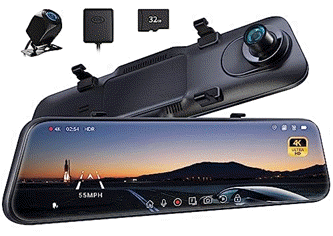Brad Templeton, Senior Contributor
2025-07-24 13:52:00
www.forbes.com
Lucid vehicle with Nuro driver added to it for testing
Self-driving developer Nuro and Luxury EV maker Lucid have formed a partership with investment from Uber to build a new player in the Robotaxi contest. Each brings an important ingredient, and together they fill an interesting strategic niche–is it the right one?
Nuro was formed by two top engineers I worked with in the earliest days of Waymo. Until recently, their goal has been to attack the more tractable pure delivery market with a custom delivery robot about half the size of traditional cars. They received a large investment and hoped to be a delivery service company with their robots. Those robots, which have no place for a human driver, are among the few vehicles to operate without human supervision on public streets in the USA, and indeed the world. They recently announced the plan to pivot towards licencing their self-driving design to partners who want to do robotaxi, delivery or other applications, rather than do it themselves.
Uber, most people know, is top brand in selling rides as a service, except in Asia. They do it with semi-independent human drivers. After a failed effort to develop their own self-driving system, which was traded to Aurora for stock, they have recently been booking rides for Waymo and have announced partnerships with several companies developing robotaxis, including VW/MOIA/MobilEye, Momenta, Motional, May and to some degree with WeRide, Baidu, Volvo, AVRide and as noted, Aurora. In this case though, they are making multi-hundred-million dollar investmants in both Lucid and Nuro.
Lucid will build the vehicles, integrating Nuro’s hardware design into the vehicles. Uber will own them and operate them and integrate them into the Uber app. Lucid is known as a high-end EV maker, though at modest volumes. Their stock saw major gains with this announcement. Lucid has a reputation for quality, and they are one of the very few to create a new car company in the USA recently, but as a luxury OEM, they are to some degree the odd one out in this trio. The partnership calls for the production of at least 20,000 cars over the next 6 years (Lucid currently makes about 10,000 per year but is growing.)
Nuro’s role is fairly clear. They have the software stack and hardware design. The actual hardware components are largely off-the-shelf including the NVidia Thor processor, and cameras, radars and LIDARs from different suppliers. For now, the software stack is the key component of a robotaxi. While there are many other components, including hardware, vehicles, infrastructure, or the network of riders and app that Uber has, these are not trivial but they are not the rare rocket science ingredient. A software stack ready to deploy in public with sufficient safety takes a lot of work and time, working through a very long tail of problems. It’s not easy to duplicate–or so Nuro hopes. Since the robotaxi business is the business of selling rides, Uber’s market-leader position is also unique, though the actual components, like the app and the backend, have been built by many companies and aren’t that hard to recreate. Building vehicles to spec is a capability found all over the world, though doing it at scale for low cost is harder.
Hardware/Vehicle Cost
Right now, vehicle hardware cost is not super important for robotaxi developers. Most of them have a literal laser focus on making their system work safely, and reducing cost in the future will be work but requires no breakthroughs. Only Tesla and some lower-funded startups have cared a lot about cost. Now that companies are scaling, the view on that will change. Right now Waymo uses expensive Jaguars, but they planned to switch to low-cost Zeekrs, a plan that may be scuttled by tariffs. They’re also working with more mid-priced Hyundai Ioniq 5s. Tesla plans a dedicated Cybercab which takes advantage of the fact that a robotaxi needs far less hardware than a consumer human driven car, they say they will make it for under $30,000. Making cars is Tesla’s strong suit. Baidu claims their 6th gen vehicle has a hardware cost of $28,000–the Chinese are the best a low-cost car manufacturing. Amazon’s Zoox is making a more expensive custom built vehicle because they believe they can differentiate from competitors with the features found only in the custom vehicle, but in time and at scale it should be possible to make it cheaper.
Competition and Luxury
Right now, there’s no robotaxi competition. Companies either are alone in their territory, or they are not in active commercial operation with full fleets, so they’re not taking business from one another. The question is, when does that change, and when it does, on what do they compete, and how important are price and luxury?
When companies begin to compete, the cost of the hardware will start to matter, because depreciation becomes the largest single component of the cost of a robotaxi ride. I estimate from 20-30% of the cost-of-goods sold. There are many factors in which robotaxi services will compete but the largest will be things like cost, wait time, service area and luxury of ride.
Waymo’s plan was a vehicle based on the Zeekr RT, which starts around $40,000, if not for tariffs.
At the start, a luxury ride make sense. Why skimp, when you’re trying to make it work and keep customers happy, not improve margins. It’s a bit strange, though, because Nuro is touting how their new design with the Lucid saved a lot of money by replacing a lot of processing with the new Nvidia Thor–just to spend it on the Gravity, which typically sells around $100,000. But later this decade they will compete, and margins will matter. It’s an open question if, when competing, offering luxury will be important or if price will matter most. Nuro’s deal with Lucid doesn’t require that all 20,000 cars ordered be the Gravity, so in future a lower cost vehicle could come, though Lucid doesn’t currently make one.
Nuro also says that because the Gravity is an electric, mostly drive-by-wire vehicle, it already has a fair bit of the hardware and redundencies they want in a design, and this reduces some costs.
Uber may place the Lucid in their UberSelect or UberBlack categories, which are pricier than regular UberX, but command higher fees. They are, based on most reports, a much smaller fraction of rides than UberX. Most Uber riders are price-conscious.
The coming landscape
The picture is blurry, but now we can see some plans that players for the competition that will come later in this decade:
- Nuro+Lucid: Luxury ride, medium sensor cost, sold through Uber
- Uber: A selection of vehicles from many vendors at different price points (as they do today with human drivers.)
- Waymo: Low priced Zeekr and medium priced Ioniq 5, with scale of first mover, sold directly by them but possibly also through companies like Uber at Waymo’s terms.
- Tesla Cybercab: Low cost vehicle made by them, lower cost rides. However, no working robotaxi as yet and vehicle not in production. Existing Teslas higher cost.
- Tesla “Network” using customer cars: Probably not practical, or only used during peak demand periods at higher prices. Off-lease Teslas could offer low cost rides if self-driving is achieved.
- Zoox: Custom vehicle, initially higher cost but with special abilities like face-to-face seating, 4-wheel steering, instant reversibility for more flexible pickup experiences and internal space.
- Baidu Apollo: Low cost vehicles and rides, not available in USA but strong competitor outside. Pony, WeRide: Similar but not as far along. Chinese vehicles will be lowest cost outside USA.
- Wayve, Aurora, MobilEye/MOIA, many others: No working robotaxi yet. VW/MOIA has ID Buzz van, somewhat costly but spacious.
- May: Only in very early operations, vehicles not yet set.
All of this is in flux and subject to change. Indeed, in spite of Nuro’s announcement of ordering 20,000 Lucid vehicles, there have been many declarations of large orders from other companies, including Waymo, that were just aspirations, and never came to pass.
Enhance your driving experience with the P12 Pro 4K Mirror Dash Cam Smart Driving Assistant, featuring Front and Rear Cameras, Voice Control, Night Vision, and Parking Monitoring. With a 4.3/5-star rating from 2,070 reviews and over 1,000 units sold in the past month, it’s a top-rated choice for drivers. The dash cam comes with a 32GB Memory Card included, making it ready to use out of the box. Available now for just $119.99, plus a $20 coupon at checkout. Don’t miss out on this smart driving essential from Amazon!
Help Power Techcratic’s Future – Scan To Support
If Techcratic’s content and insights have helped you, consider giving back by supporting the platform with crypto. Every contribution makes a difference, whether it’s for high-quality content, server maintenance, or future updates. Techcratic is constantly evolving, and your support helps drive that progress.
As a solo operator who wears all the hats, creating content, managing the tech, and running the site, your support allows me to stay focused on delivering valuable resources. Your support keeps everything running smoothly and enables me to continue creating the content you love. I’m deeply grateful for your support, it truly means the world to me! Thank you!
|
BITCOIN
bc1qlszw7elx2qahjwvaryh0tkgg8y68enw30gpvge Scan the QR code with your crypto wallet app |
|
DOGECOIN
D64GwvvYQxFXYyan3oQCrmWfidf6T3JpBA Scan the QR code with your crypto wallet app |
|
ETHEREUM
0xe9BC980DF3d985730dA827996B43E4A62CCBAA7a Scan the QR code with your crypto wallet app |
Please read the Privacy and Security Disclaimer on how Techcratic handles your support.
Disclaimer: As an Amazon Associate, Techcratic may earn from qualifying purchases.














![Massive Apple deal event – M3 iPad Air all-time low, AirPods, M4 MacBooks $300 off, more [Updated]](https://techcratic.com/wp-content/uploads/2025/08/AirPods-Pro-2-AirPods-4-360x180.jpg)


























































![BASENOR 3PCS Tesla Model Y Model 3 Center Console Organizer [Carbon Fiber Edition]…](https://techcratic.com/wp-content/uploads/2025/08/71R5dfCR9FL._AC_SL1500_-360x180.jpg)















![Alien: Romulus – 4K + Blu-ray + Digital [4K UHD]](https://techcratic.com/wp-content/uploads/2025/08/81fBb0Z1egL._SL1500_-360x180.jpg)
















